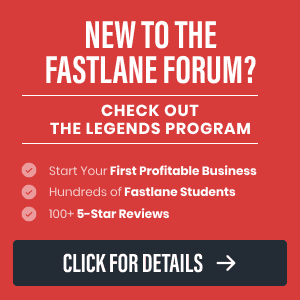G-Man
Cantankerous Contributor
FASTLANE INSIDER
EPIC CONTRIBUTOR
Read Fastlane!
Read Unscripted!
Summit Attendee
Speedway Pass
User Power
Value/Post Ratio
543%
- Jan 13, 2014
- 1,998
- 10,859
So, it seems like many, if not most of the folks on the forum are in some kind of “online” work. I don’t see too many people that are selling a physical branded product into boring B&M stores, and none so far in food products. I love physical products, so I thought I’d share some thoughts about physical products (using food as an example) and CENTS for folks who are toying with the idea of going “offline”.
This is by no means extensive, and there are definitely down sides, but I feel like a lot of people don’t even consider mass market physical products, and might be missing out on a huge fast lane
- NEED – Most of human life takes place offline, believe it or not. We all have products in our lives that we believe could be better. You probably have some in yours. Or maybe you’ve heard a relative say “I really wish they made a ____________ version of this” Do some research, what pain points do people have in the products they use every day.
- ENTRY – This is what I love most about physical products. When you work online, every idiot with a laptop tries to crowd your market. I’m not saying they can do what you can, or their value add is as big as yours, but they add a ton of noise to the market. You don’t find the idiot crowd too often in the supermarket. It’s too much work, and most people have the mistaken idea that you need a factory to get your product out there.
- CONTROL – This one, honestly, is tough. You are at the mercy of merchandisers at first. The way to overcome this is to aim big and shoot for a product so ubiquitous they can’t not carry it. Think Coke or Lay’s.
- SCALE – Everyone that walks into a grocery store/Walmart/convenience store. Everybody. It doesn’t get as much press as tech companies, because it’s not as sexy, but it’s not uncommon for food companies that get to 10+million in sales to sell at 15+ EBITDA multiples to the big boys. This is because the potential scale is everyone with a mouth.
- TIME – It’s extremely time intensive upfront, but the return on time grows geometrically as distribution grows. It’s just as much work to get a 100 store chain as it is a 1,000 store chain. You get to the point where you’re only taking time for the bigger calls, then all your little soldiers are on the shelf, calling out to the consumer, and turning back to the bank account.
This is by no means extensive, and there are definitely down sides, but I feel like a lot of people don’t even consider mass market physical products, and might be missing out on a huge fast lane
Dislike ads? Remove them and support the forum:
Subscribe to Fastlane Insiders.
Last edited by a moderator:
